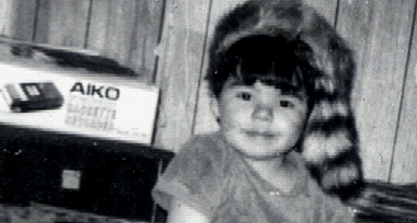It has been 17 years since I spent the better part of two summers on White Otter Lake; manually and photographically recording the pictographs ("Rock Art" paintings) that were scattered across the large, sprawling lake and down the Turtle River.
Last week, my father and I went back out on the lake with some acquaintances from the Fort Frances Museum, to see the pictograph sites and get out in the woods for a couple days.
Unfortunately, we were a little short on: time, gasoline and my memory recall. We didn't reach the east end of the lake or find the best panel on the west end. The panels that we found were faded and/or suffering from the exfoliation of the rock surface; probably exacerbated by a decade(s)-long submergence at the turn of the century, when the lake was dammed and flooded to facilitate logging of the white pines. Subsequently, the rock became saturated and more subject to the freeze/thaw cycle. In addition; Barry Brown (of Brown's Clearwater Lodge) believes that people are touching the pictographs, with their hand lotions, sunscreens and bug dope; subjecting them to novel solvents that prehistory hadn't subjected them to.
Mr. Brown has been up at Clearwater Lake for 35 years and has noticed that the pictographs on Clearwater have noticeably faded.
In addition to visiting the few pictograph sites that we could locate, we: visited the White Otter Castle, searched for the P.O.W. camp, inspected mysterious "pits" on a moraine island, (Dad and I) wasted a collective hour trying to catch a fish -any fish- and enjoying relatively bug-free, gorgeous camping.
The following photos of the pictograph panels come in sets of three: The original, an "eyeballed" enhancement filled in with MSPaint and the third photo digitally enhanced with an online digital-photo processor (links below), ImageJ.
One of the ideas that I have been kicking around, for a while, is that an effort should be made to photograph currently known pictograph panels [and panels that "should have" rock art paintings, but do not present any visible pigmentation] with "Multi-spectral imaging"(Wikipedia article); a photography technique that uses infrared and UV filters combined with digital photography, to differentiate faded, hidden and buried pigments in ancient papyrus scrolls.
This would be a more direct means of image enhancement than processing, after-the-fact.
Multi-spectral imaging, has alsready been used on Mayan cave-pictographs at Naj Tunich, Guatemala.
Here is a website with an interactive flash demonstration of the technique, on papyrus scroll.
---
"Dstretch" (plugin for "ImageJ" photo editor) article. Dstretch page, with link to an online applet version. ImageJ: Free "image processing and analysis" program (for Java).
--------------------------------------------------------------------------------------------------
Pics click to enlarge:
Large boulder wedged under an overhang; south part of West arm.
Original
MSPaint 'enhanced'
"ImageJ" processed
Eastern face of island overhang; half way up West arm
Original
MSPaint 'enhanced'
"ImageJ" processed pic:
The high-panel site.
The high-panel site, panel 1.
Original
MSPaint 'enhanced'
"ImageJ" processed pic:
The high-panel site, panel 2.
Original
MSPaint 'enhanced'
"ImageJ" processed pic:
---
The mysterious "pits", on moraine island. Archaeological buddies of mine had speculated that they may be related to the "Pukaskwa pits". They appear to be too large and regular to be natural "rootfalls".
---
White Otter Castle
---
We never were able to find the POW camp, but Pam found an oil/diesel drum dump. The best that I was able to scare-up was a possible dock beam.
--------------------------------------------------------------------------------------------------
Native film grads told to set record straight
Native tongue
"That the Children's Theatre Company is staging another new script isn't really news - the Minneapolis theater has churned out a veritable parade of world premieres under the artistic directorship of Peter Brosius.
That "Average Family" is a premiere by American Indian playwright Larissa FastHorse, though, is something worth noting."
What is the Truth About the Murder of Anna Mae? An article by Tim Giago.
"That's not safe"
---
I just finished listening to a great scifi audiobook from podiobooks.com (Free; with donation request. A great resource!),
Amerindian 2192,
by J. Scott Garibay (Mattaponi).
Listen to the promo.
--------------------------------------------------------------------------------------------------
Tags:


3 comments:
hey man, could those pits be related to the up north gold rush? theres pits like those all around lake vermilion, and old guys told me they were test pits dug by hopeful prospectors...
Not likely. The whole island is a glacial moraine; little more than boulders, gravel and sand. The top part, where the pits are, is just sand. I've seen exploratory trenches for hard rock mining where I grew up and they're nothing like these.
The hill part of the island with these pits is about two hundred feet up and a steep climb. It has a great view of the southern approach to that part of the lake. They almost look like they would make great "lookout points", if you can imagine them freshly dug and not filled in by erosion, etc.; but for what/whom? They are all over the hill, without apparent pattern.
I thought they may have been holes left by the upturned roots of windfall trees; but they are very round; missing the assymmetric distribution of dirt to one side, that you see when a big root system is pulled up.
All I can say is that they look artificial. Without an archaeological excavation, it's impossible to say for sure what they are and nobody in Ontario archaeology is curious enough to check it out. Yet.
:Eric
Here is some photo's of a pictograph site in the Fraser Canyon that cant be accessed by the public at this time, I believe these may be the first public photos of this site, from Tuckwhiowhum Native Village in Boston Bar BC http://travelthecanyon.com/tuckkwhiowhum/nativepictographs.html
Post a Comment